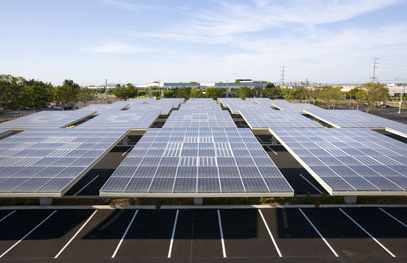Solar structures offer self-sufficiency in disaster
Envision Solar announces prefab solar-powered structures for disaster areas and developing nations and new solar carports with tracking system.

San Diego-based Envision Solar, a manufacturer best known for its solar carports, announced two new products Wednesday that expand on the company's idea to utilize solar energy in unusual places.
The LifeVillage is a series of prefab structures framed with light-gauge steel that employ solar panel roofs and can be deployed quickly to disaster areas to provide temporary shelter and electricity, as well as purified water.
Think of LifeVillage as a low-budget version of a Huf Haus. Only instead of being built by German engineers in a pristine factory, the LifeVillage structures can be built on site by unskilled workers with the prefabricated materials arriving in two standard shipping containers.
One kit includes energy storage batteries, photovoltaic modules and corresponding roofing, a water pumping and purification system, inverters, and lighting. The light gauge steel frame enables the structures to meet international building codes, according to Envision.
A single LifeVillage structure offers 3,500 square feet of self-sufficient living or working space. They're also designed to be flexible and modular so that they can be used alone as a shelter, or in multiples for larger needs such as health clinics in areas with no available utilities. Each module can generate up to 50 kilowatts of power to be used for a combination of things like refrigeration, water purification, communications, or as a large-scale charging source for cell phones.
While the prefab solar building idea would obviously not work for every climate, Envision points out that it could be an ideal source of shelter and energy in areas like Haiti, India, and parts of Africa.
The other product announced Wednesday expands on Envision's existing solar carport structures.
The Envision SolarTree, a solar covered carport, has been coupled with a new tracking system called EnvisionTrak. It tracks sun movement to maximize the amount of solar energy that can be captured by solar panels on Envision carports beyond the peak hours of noon to 3 p.m.
Envision will begin offering Axion Power batteries with its carport systems to store solar-generated electricity for later use after the sun goes down.
"Axion's PbC batteries extend the capabilities of the Solar Tree by enabling it to charge a battery during the day and continue to generate power at night. The combination of these two innovations will drastically impact the capabilities of the SolarTree," Envision CEO Bob Noble said in a statement.
Carports, once largely abandoned in favor of open-air parking lots, have been making a comeback in recent years as solar companies look for underutilized places to put photovoltaic modules, and manufacturers of plug-in electric vehicles look for ways to offer convenient charging stations.
In addition to Envision Solar, SunDurance also does solar-covered carports, and recently announced a project at New Jersey's Mennen Arena. In March, it was announced that Sanyo would provide some of its facilities with solar carports for charging electric bicycles. And in April 2009, the city of Chicago installed tree-shaped solar carports that act as plug-in stations that can recharge two cars at a time. Even Google now has solar carports for its employees.

